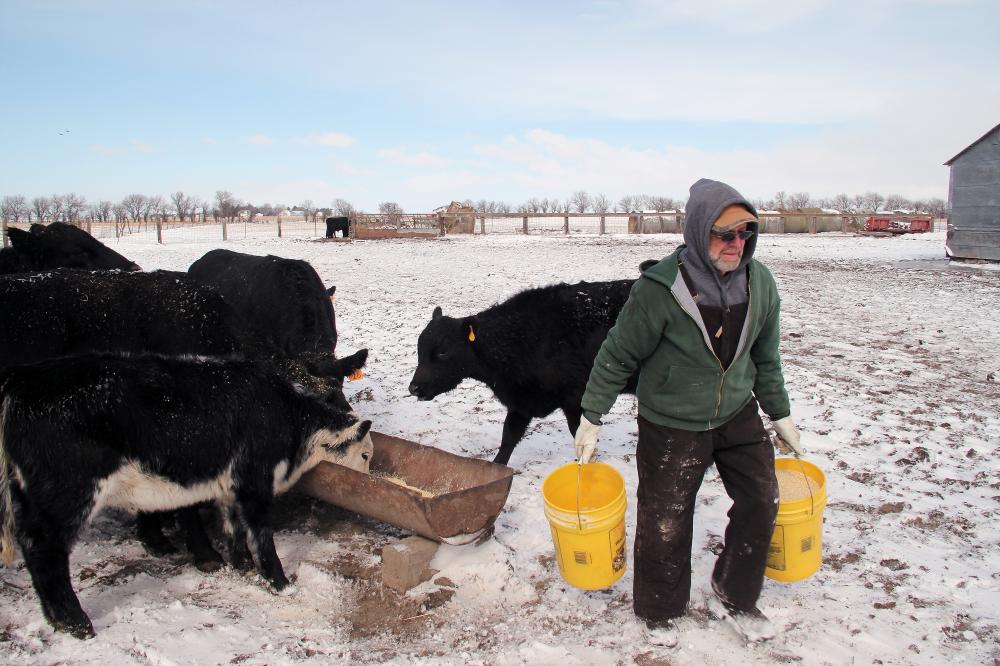You’ve probably seen, but may not have noticed, labels on the meat at your grocery store that say something like “Born, Raised, & Harvested in the U.S.A.” or “Born and Raised in Canada, Slaughtered in the U.S.”
These country-of-origin labels, as they are known, are part of an ongoing international trade dispute that has swept up Midwest ranchers. And they may not be long for store shelves.
The 2002 Farm Bill was the first to require country-of-origin labeling on meat. It took another seven years of rulemaking and legal wrangling for the labels finally to reach supermarket shelves in 2009. But last October, the World Trade Organization, ruled that the labels were an unfair trade barrier for meat producers in other countries. That has left the labels — and the meat industry — in limbo.
More than 90 percent of the beef, pork and poultry consumed in the U.S. is produced by American farms — but as the labeling fight has proven, many ranchers want you to see that for yourself.
Gayland Regier is one of those ranchers. He grows corn and soybeans and has a small herd of cattle near Beatrice, 50 miles south of Lincoln in southeast Nebraska. On a cold, windy afternoon he carried a couple buckets of feed into a cattle corral, and his calves came running.
“I have pride in the way we take care of cattle, the way they’re treated,” Regier says. “I shouldn’t say it, but I tend to love each one of ’em. But they’d probably tell me ‘not if I’m going to slaughter.’ ”
Meat from his grown calves someday will end up on a supermarket shelf. When it does, Regier wants the label to state clearly that the meat was made in America. For Regier and other ranchers, “Buy American” is a good marketing slogan, whether you’re selling cars or cattle.
“The meatpackers want to make the meat product that comes from the foreign countries a generic product that doesn’t require labeling,” Regier says.
Meatpacking companies have indeed fought country-of-origin labels since they were created in 2002 — so have livestock producers in Canada and Mexico — and they may be closer to peeling them off.
Mark Dopp, senior vice president of the meatpacking industry group the North American Meat Institute, says the labels are an economic burden. Packers have to keep track of where animals are born, raised and slaughtered. The easiest way to do that is to separate imported livestock from American animals.
“So the coolers are segregated, the lines are segregated, because when the products get to retail, the retailer needs to know what labels go on what product,” Dopp says.
The labels don’t have anything to do with food safety, Dopp says; they don’t make it easier to trace food back to the farm, either. But to keep things simple, Dopp says some packing plants and grocery stores could decide to go all-American. That would hurt the market for, say, a Canadian rancher hoping to sell to the U.S.
“If we’re a country that believes in free trade, and if we’re a country that believes in adhering to our international trade obligations, is it appropriate for the United States to have a statutory scheme that discriminates against certain producers?” Dopp asks.
Canada and Mexico took that question to the World Trade Organization. Last fall, they won. The WTO ruled that the information on country-of-origin labels on meat is not worth enough to consumers compared to what it costs the industry.
Country of origin isn’t really influencing what people buy, according to some research. Glynn Tonsor, an agricultural economist at Kansas State University, analyzed checkout data and found that shoppers tend to pay more attention to things like price.
“That makes one a little bit pessimistic about whether there’s a real benefit, from a consumer-demand perspective,” Tonsor says.
But Patty Lovera, assistant director of the consumer advocacy group Food and Water Watch, says surveys have shown consumers do want to know where their meat comes from. How they act on that information, she says, is up to them.
“To be having this fight is kind of amazing, when the trend on everything else on food is giving people more information,” Lovera sayd. “These guys are fighting to not give this basic stuff.”
The U.S. has appealed the WTO ruling against the labels, and the debate about country-of-origin labeling continues. But with Canada threatening trade sanctions if the U.S. doesn’t drop the labeling requirements, Congress may move first: Lawmakers could repeal the labels, or change the language to something like “raised and slaughtered in North America.”
To farmer and rancher Gayland Regier, that wouldn’t be saying much. He’s concerned meatpackers could use imported cattle to water down prices for American ranchers, and labeling makes that harder to do. And with America meat companies extending their reach beyond the borders of the U.S., country-of-origin labels can also help U.S. cattle producers stand out from the global competition, Regier says.
“Why can’t we differentiate [our meat] from that which comes in from other foreign countries?” he says.
According to a report in Politico Friday, the WTO is expected to issue a final ruling on the country-of-origin labels by May 18.
This story comes to us via Harvest Public Media, a public radio reporting collaboration that focuses on agriculture and food production issues.
9(MDA3MTA1NDEyMDEyOTkyNTU3NzQ2ZGYwZg004))
